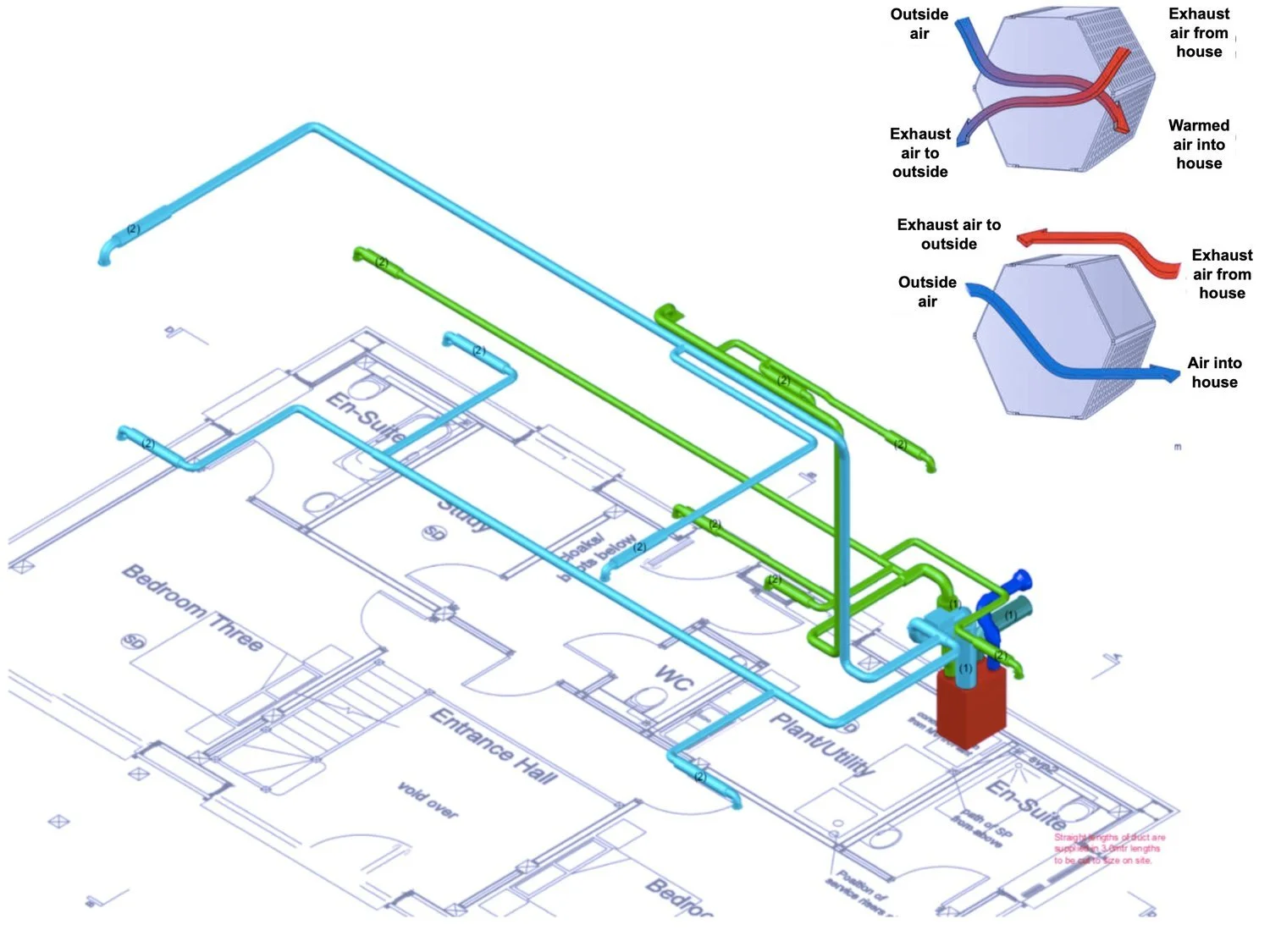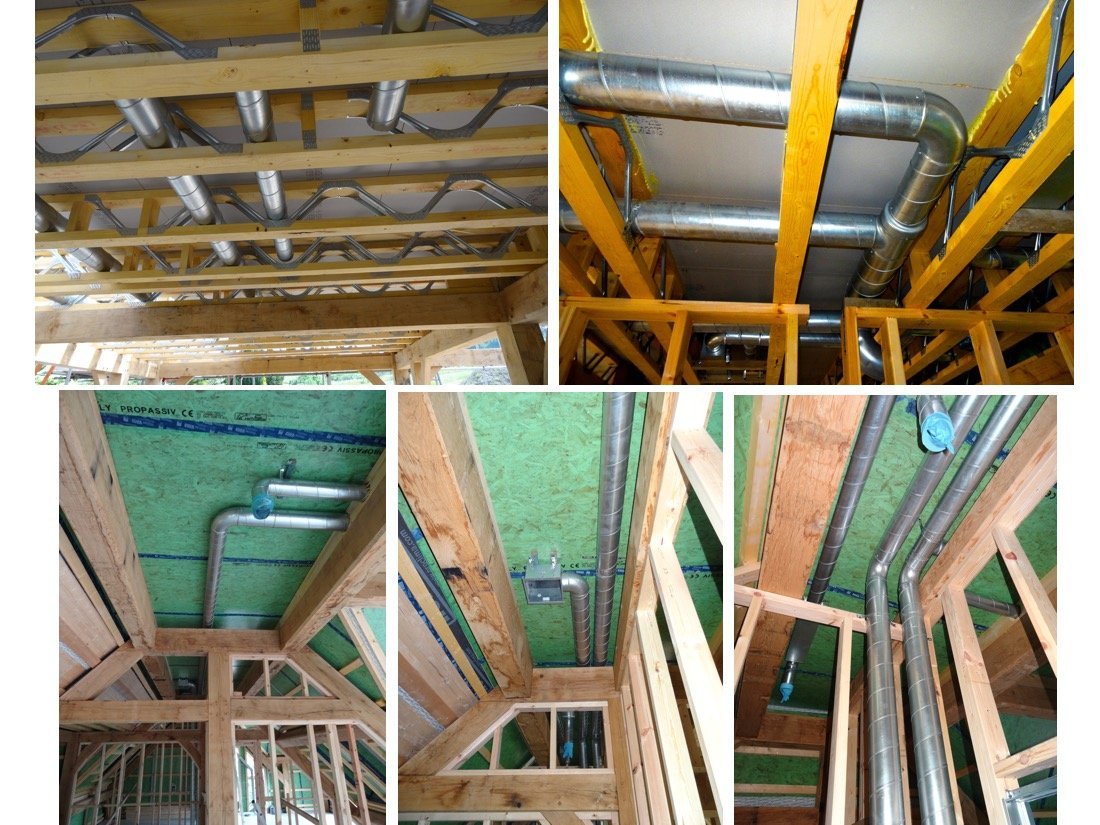Passivhaus: top quality indoor environment
For us, the most striking feature of Passivhaus living is the consistently high quality indoor environment. This has three features:
outstanding thermal comfort - due to the various aspects of Passivhaus design: high levels of insulation, minimisation of cold bridging across the insulation, air tightness, triple-glazing and solar gain optimisation, and the mechanical ventilation heat recovery (MVHR) system;
constant fresh air without any draughts - due to the MVHR system and exceptionally high levels of airtightness; and
excellent humidity control - there is no dampness or condensation or mould, again, due to the MVHR system, triple glazing, high insulation levels and minimisation of cold bridging.
A near-constant indoor temperature throughout the house
Towards the end of an earlier post you can see how our indoor temperature varies little throughout the day and all year round despite what is happening outside.
In 2022 we had two periods of relative heat extremes - the July heat wave and the December cold snap - when outdoor temperatures at Woodlands reached +34.06°C and -9.77°C, respectively. These provided a good test of the design and build quality of our passive house; it passed with flying colours.
Thermal comfort during outdoor temperature extremes
Indoor (master bedroom) and outdoor (shade) temperatures: 00.01 16 July – 24.00 19 July 2022
On the right you can see what happened during the heatwave: the indoor temperature slowly increased over the whole period from 21°C to just 25°C (red line), whilst our neighbours complained of indoor temperatures of 33-34°C. Only just did the temperature indoors exceed 25°C at Woodlands and then only for one hour during the night on the final day. At no time did we need fans for cooling, and we slept well. We achieved this by:
keeping all windows shut during the day;
closing internal and external blinds on south-facing windows during the day;
operating the ‘cooler battery’ when the indoor temperature exceeded 22°C (see ‘Cooler Battery’ section in this post about our mechanical ventilation heat recovery system); and
‘Mediterranean purging’ (opening some downstairs and upstairs windows at night to remove excess heat), which was less effective than usual because night-time outdoor temperatures stayed high, hence the small increase in overall indoor temperature over the four days of the heatwave.
Indoor (master bedroom) and outdoor (shade) temperatures: 00.01 12 December – 24.00 17 December 2022
And on the right here you can see what happened during the December cold snap: the indoor temperature varied remarkably little and even when it reached -9.77°C outside during one night the indoor temperature went down to just 19.30°C.
The underfloor heating system came on for only a few hours each day during this time. (The effect of the sun on indoor temperature is important: we only need to use our heating system when it’s very cold outside and there are several consecutive overcast days with no sunshine at all.)
And, as we expected, all rooms were warm right up close to the windows - there was no ‘cold radiant’ nor convection currents because of the effectiveness of the triple-glazing.
Gentle warmth seems to come from everywhere
In the short video on the right, Mark Tiramani talks about his experience of living in a Passivhaus. It’s the same as ours: there are no cold spots, damp, condensation or varying temperatures, and no discomfort from draughts; it’s just the same high quality environment everywhere.
And, as Mark says, you notice this especially on cold days: there’s a gentle warmth that seems to radiate from everywhere as you come through the door. And we find the equivalent on hot summer days too: a gentle coolness from everywhere. (On very hot summer days we’ve had workmen reluctant to go to their next job because it’s so pleasant inside!)
Constant fresh air
On the right you can see our mechanical ventilation system design. This shows both downstairs and upstairs ducts although only the ground floor room layout is shown.
The blue ducts bring fresh air into living areas and the green ones extract air from the bathrooms and kitchen changing the air in the whole house roughly once every two hours. The red box, bottom right, is the MVHR unit.
This picture also depicts the heat exchanger inside the MVHR unit (inset, top right). In colder months (upper inset), this extracts 90+% of the outgoing air’s heat and transfers it to the incoming air via a series of thin metal plates; the air streams don’t mix. In warmer months this is automatically bypassed (bottom inset), also helping to cool the house.
In the photos on the right you can see some of the ventilation ducts before they were hidden behind plaster-board.
The beauty of the MVHR system is threefold:
the house always has fresh air, like having a window open in each room but without any draughts;
it’s very efficient - it’s much cheaper to extract heat from outgoing air and use it again than to warm rooms afresh to make up for heat loss from ventilation; and
you can’t hear it - many of our B&B guests have tried and none have succeeded.
And, of course, mechanical ventilation is consistent and continuous; it’s not subject to the varying effects of outdoor air pressure and wind on trickle vents and opened windows, or on air leaks in the house’s fabric (which are virtually absent in a Passivhaus).
Relative humidity
On the right you can see that the relative humidity levels in the house remain within an optimal range almost all of the time because of the MVHR system.
The house is always free of condensation (other than an occasional slight and short-lived misting of a bathroom mirror after having a shower), there is no mould anywhere, and we have never felt that the air was either humid or dry.
What’s not to like!
Experience the Passivhaus difference for yourself by staying at Woodlands




